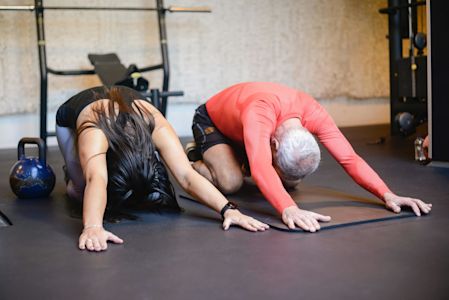Your strength journey starts here – with a free set of bands
Get a free pack of resistance bands when you sign up to The Body Coach app this November.
Subscribe now to The Body Coach app and start your strength journey — limited-time offer.

In this blog, Tim Morton, Physical Activity Programme Lead at Parkinson’s UK discusses the importance of people with Parkinson’s moving their body – in whatever way they can.
Parkinson’s is a degenerative neurological condition and currently there is no cure. Despite improvements in treatments, it can be tough, with more than 40 symptoms affecting both mind and body.
Those symptoms include tremor, problems with balance, stiffness, inflexibility, insomnia, depression and anxiety, all of which are considerable barriers to face when trying to live your life, let alone being active.
Some days it can be hard to be positive when living with Parkinson’s, but following guidelines of being physically active for 150 minutes or more a week can really help manage symptoms and improve physical and mental wellbeing.
HIIT has been shown to be beneficial for those with Parkinson’s, as high intensity exercise has a positive impact on the health and development of neurons in your brain. Neurons are nerve cells that send messages to different parts of your body to allow you to do things such as breathing, moving, talking and thinking. It’s an all-round workout that we’d recommend, but with a few caveats of course – as, like everything, it’s not for everyone.
A few years ago a colleague and I visited a non-contact boxing session in Manchester and met a couple who had travelled from Leeds to take part, which they did weekly. They walked into the class with determination and obvious Parkinson’s symptoms. An hour later they left dripping with sweat and big smiles on their faces, and not a hint of Parkinson’s between them.
That’s how powerful being active with Parkinson’s is.
But after one person described the condition to me as "like having permanent jet lag, alongside tremors, freezing, falling, anxiety and depression", you begin to understand that it’s not just as simple as helping someone get to a gym and telling them to do a HIIT session.
“If you’ve met one person with Parkinson’s, you’ve only met one person with Parkinson’s”. We use this quote a lot, and it’s a good one to remember when you support or meet someone with the condition. Everyone has a different combination of symptoms, reaction to medication, physiology and relationship with exercise, as well as potentially other health conditions to cope with.
Being active at vigorous levels of intensity can have a profound effect on managing symptoms and living well with Parkinson’s, but it doesn’t have to be about HIIT sessions.
We’ve seen people on an absolute high from an intense workout, but also people beaded with sweat and grimacing while doing sit to stand from their wheelchair. It’s all relative and all really good, but there isn’t a one size fits all here.
What if you are facing multiple barriers even to get to a point where you can leave the house? If we are being realistic then let’s acknowledge that it’s not always easy to be active.
So, what do we at Parkinson’s UK say to people with Parkinson’s about being active?
Some is good, more is better Whatever you can do will have an impact, but try not to get too hung up on intensity – a better word to focus on is challenge. Challenge yourself to make a start, to do a bit more, go a bit further, take an extra step.
Make it social It’s not for everyone, but if you can be active with other people whether it’s in a class, a group or just being out with a friend, the benefits to your mental as well as physical wellbeing can be really significant. We know that the cuppa and chat after a session are often reported as doing as much good as the actual workout, it’s a great way of connecting, relaxing and sharing.
Keep it enjoyable and varied Do what you enjoy - it’s a simple and obvious message, but a very important one. If you hate going to the gym, then don’t go - find something you enjoy and do that instead. And if you don’t know where to start, try a few taster sessions online at home. You can sample walking, dance, football and so much more all from the privacy of your living room. And as always, variety is the spice of life. Aim for a variety of activities each week; whatever you can do will have a benefit.
Challenge your mind Being active can be about switching off, but it can also present an opportunity to be mentally agile as well. How about trying to count backwards from a hundred in sevens as you are on a treadmill, or spelling countries backwards as you play golf? Making your brain and body work at the same time is a great way of staying sharp and really feeling the benefits of the hard work you are putting in.
So, that’s some good advice for people with Parkinson’s, but what about the people who help them to be active?
Ask yourself this – ‘am I Parkinson’s aware?’ Some need help with balance, some with strength, some with flexibility and people can be very different day to day (and even hour to hour). The easiest thing to do is listen.
If you can support people with Parkinson’s to be active, you are doing a great thing.
Don’t forget that intensity is all relative - and people with Parkinson’s are fighting unseen battles every day.
Find out more information about Parkinson’s and physical activity.
There is a 20-minute HIIT workout for Parkinson's on The Body Coach TV. Try it out here or share with someone who may benefit.